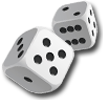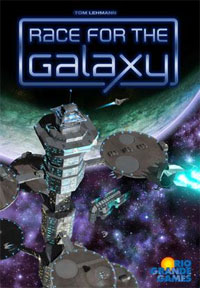



play board games
Board game reviews, strategy tips & session reports
Race for the Galaxy Review
 Stats:
Stats:
No. of players: 2-4
Amount of time to play: 30-60 min
Age requirements: 12+
Set-up time: minimal
Race for the Galaxy Rules Description:
Race for the Galaxy is a highly strategic and complex card game. In this space-themed game you explore and settle (or conquer) new worlds to see who can build the most prosperous and powerful space empire.
If you have ever played Puerto Rico or San Juan, you will understand the basic groundwork of Race for the Galaxy. In fact designer Tom Lehman was working on a card game version of Puerto Rico (named San Juan) which lead to the development of Race for the Galaxy. If you haven’t played either Puerto Rico or San Juan you will still enjoy this game. The learning curve might be a little steeper though.
To start the game you place 12 victory points per player on your playing surface, deal each player a starting world and deal each player six cards. Players can only keep 4 of the initial six starting cards they receive. You also start with seven action cards that are the same for all players. These are the cards that determine what phase you want to play and get a bonus in. You play one per round and may use them over and over again. In Race for the Galaxy there are five action phases: Explore, Develop, Settle, Consume, and Produce.
Your main hand of four cards is made up developments and worlds. These cards have three uses: play them in front of you (on your Tableau), discard them to pay for placing a card, or to represent goods you have produced.
At the beginning of the round you secretly choose which action you wish to take using one of your seven action cards. Then everyone reveals their choices and each player has the chance to perform that phase (in the order above). When you play the phase of the action card you revealed, you get a bonus for that phase. For example, if you choose to Develop everyone may Develop if they wish. Your bonus for playing the Develop card is that your development costs one less card to place in your Tableau.
“So why are there five phases and seven action cards?” you ask. Good question. The answer is that there are two different Explore action cards and two different Consume action cards. Depending on which you play you get a different bonus.
The first phase is Explore. During this phase you draw two cards and get to keep one. If you played your Explore:1+1 action card you draw three cards and get to keep two. Playing your Explore:+5 action card gets you seven cards but you still only keep one.
Develop allows players to place development cards in your Tableau. As I stated before the bonus is that your development costs one less card to place.
During the Settle phase you may place a non-military world for its cost or you may place a military world for free. Military worlds may only be placed if your military value is equal to or greater than the value of the military world. Your bonus for laying the Settle action card is drawing one card.
Consume:Trade happens before the normal Consume phase and allows the player to sell one good. Selling a produced good adds cards to your hand based on the type of good and its rarity. The Consume phase forces players to Consume any goods they have. Consuming goods gets you victory points and must be done. (This is similar to the Captain phase in Puerto Rico.) Comsune:2x doubles your victory points for consuming.
Produce lets you place a good on any production worlds you have that do not already hold a good. Simply take a card from the draw pile and place it face-down on your production world. The bonus from playing the Produce action card is getting to produce on a windfall world. Windfall worlds start with a good on them but cannot normally produce goods again.
The cards you play on your Tableau are worth victory points and will sometimes give you a bonus in one or more of the phases. They are cumulative and figuring out good card combos is a large part of the game.
The game ends when either all the victory points are gone or someone has 12 cards in their Tableau.
A Quick Review of Race for the Galaxy:
Race for the Galaxy is pretty complex and will take a couple plays to take in. as I stated above the mechanics are similar to both Puerto Rico and San Juan. I still really enjoy this game a lot. After a few plays the elegance and balance in this game becomes apparent. An even for how complex it is it is not complexity just for complexity’s sake. It only takes a half hour or so to play which is great. Not too long or too quick.
There is a lot of information on each card and it is done through an icon system. This also adds to the learning curve, but is done extremely well. The amount of information communicated on each card is incredible.
My biggest complaint about Race for the Galaxy is the rules. The rules for are hard to understand as written. I read a lot of game rules and these left me a bit confused. I found this excellent video tutorial which helped and we still played the game wrong three times. I recommend reading the rules, watching the video then reading the rules one more time.
This game may take a few plays to get into but if you are looking for a deep, complex yet quick game, you will really enjoy Race for the Galaxy.
Score and synopsis: (Click here for an explanation of these review categories.)
Strategy 5 out of 6
Luck 4 out of 6
Player Interaction 3 out of 6
Replay Value 6 out of 6
Complexity 6 out of 6
Fun 6 out of 6
Overall 6 out of 6

Leave a Reply